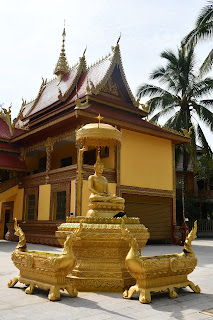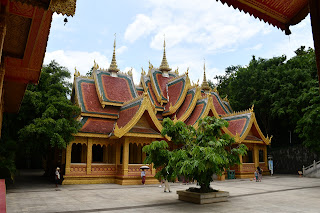Sipsongpanna
The one thing I really wanted to do in Sipsongpanna was to
visit the Dai Ethnic Garden. A collection of villages dating back as far as
1400 years ago, the site boasts a number of temples in the Dai style.
I ate lunch at the temple and drank some coconut milk (I will miss fresh tropical fruit when I get home). The driver took me back to the hotel, where I tried to tip him for taking a longer route and he steadfastly kept on refusing.
That morning, the manager’s wife arranged for some contact
of hers to drive me around for the day, telling him, as we were leaving, that he
should stop if I wanted to buy fruit or anything on the way. The driver, of
course, took the injunction with utmost gravity and earnestly insisted – over my
protests that it really wasn’t necessary – that he take me to a fruit market
near the Dai Ethnic Garden. I quickly relented. Not wanting to disappoint the
driver, I bought a whole bag of rambutans, which I would consume over the
course of the next twenty-four hours.
The Dai Ethnic Garden was surprisingly peaceful, quite
likely because we arrived relatively early in the morning. I figure most
tourists arrive later, when the locals recreate their New Year’s celebrations –
yes, they do this on a daily basis. I did not really want to wait for that, so
I just visited the temples I wanted to see, passing by banana farms and wooden
houses with orchids in hanging coconut shells. It was hot and humid, and the
skies were just cloudy enough for mosquitoes to have the audacity to suck
people’s blood in broad daylight.
Dai Ethnic Garden Entrance
Man Jiang Village Buddhist Temple entrance
Man Jiang Temple
Another building at Man Jiang Temple
A dragon at Man Jiang Temple
A statue of Sakyamuni at Man Jiang Temple
Flower bush
Fence ornament
A wilting tropical plant
Massive jackfruit
Man Song Man Village Temple
The interior of Man Song Man Temple
The central building at Man Song Man Temple
A waterfall at Man Song Man Temple
Elephant statues at Man Song Man Temple
Golden Stupa at Man Song Man Temple
Another shot of Man Song Man's Stupa
Golden elephant at the Dai Ethnic Garden
Man Zha Village Temple
Man Zha Village golden peacock
Golden elephant detail
Man Ting Village white tower
Banana plantation
Villagers watching a cockfight
A structure under reconstruction at the Dai Ethnic Garden
On the way back, my driver stopped to buy pineapples for some
relations he was going to visit the next day. He was very apologetic about
making the stop and bought me some pineapple to make up for it. I had forgotten
how good fresh pineapples tasted.
Since it was still quite early in the day, I asked the
driver whether we could make a detour to the Mengle Buddhist Temple. Not only
was he very happy to; he also helped me get a discount at the gate.
The Mengle Buddhist Temple boasts of being the largest
Theravada temple in China, which is admittedly not very difficult in a country where
Theravada Buddhism is constricted to a few regions in the far south. From the
information available, I cannot quite piece together the exact history of the
entire compound. Some official websites claim the temple was originally built during
the Ming dynasty, destroyed in 1848 during a(n unspecified) war, and rebuilt
again in 2007. Other websites make it sound as though the temple was built from
scratch and newly consecrated that year to consolidate Dai culture. I assume
there must have been some temple on the site previously, but what stands there
now is much bigger and more lavish: A giant standing golden Buddha and several
big temples covered in golden decorations. The whole complex takes the shape of
a meditating monk.
I ate lunch at the temple and drank some coconut milk (I will miss fresh tropical fruit when I get home). The driver took me back to the hotel, where I tried to tip him for taking a longer route and he steadfastly kept on refusing.
The central building of the Mengle Buddhist Temple
Matsya
Great golden Buddha
Another temple at Mengle
An ascending row of important Buddhist figures
The central temple from above
The long snake tails carry on for dozens of metres along the steps
Golden Buddha with Sipsongpanna in the background
Golden tower at the top of Mengle's hill
A monk giving a tour
A hallway
A holy rock with the great golden Buddha in the background
Later in the afternoon, I crossed a bridge above the Lancang
(the upper half of the Mekong River) to visit the Great Golden Tower Temple (Dajintasi)
on the other side of the river. As is the case with many other buildings in
China, this temple was destroyed and rebuilt several times – last time during and
after the Cultural Revolution – which means that its current iteration is giant
and one can hardly tell what, if anything, is faithful to the original. The
plaza by the riverbank is still in the process of being constructed, offering
current visitors the hilarious sight of blow-up plastic palm trees lining the
main path towards the temple.
The view of Dajintasi from my room
The bridge over the Lancang
Lancang River
The modern part of Sipsongpanna
Dajintasi
A side entrance to Dajintasi
A stone guardian
Buddha riding an elephant
The (hopefully) provisional decorations of the plaza below Dajintasi
Reclining Buddha
Dajintasi from a bridge
Dajintasi behind a bridge
Dajintasi over the water
A cruise ship
I ate a lot of my rambutans for dinner.






















































你沒有迷路!
ReplyDeleteDon't worry, being not lost is only a temporary state of being.
ReplyDelete